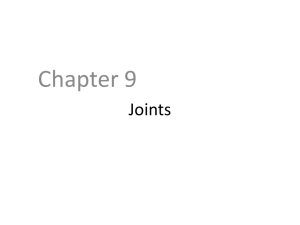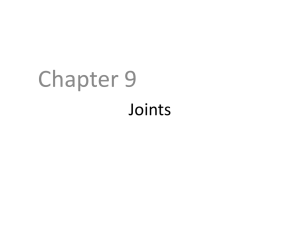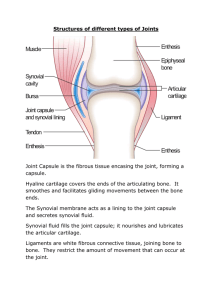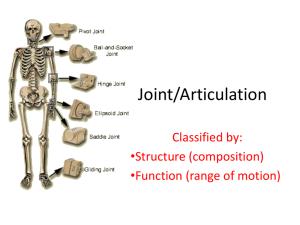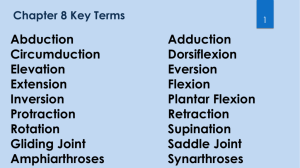A RTICULATIONS Joints where 2 or more bones interconnect
advertisement
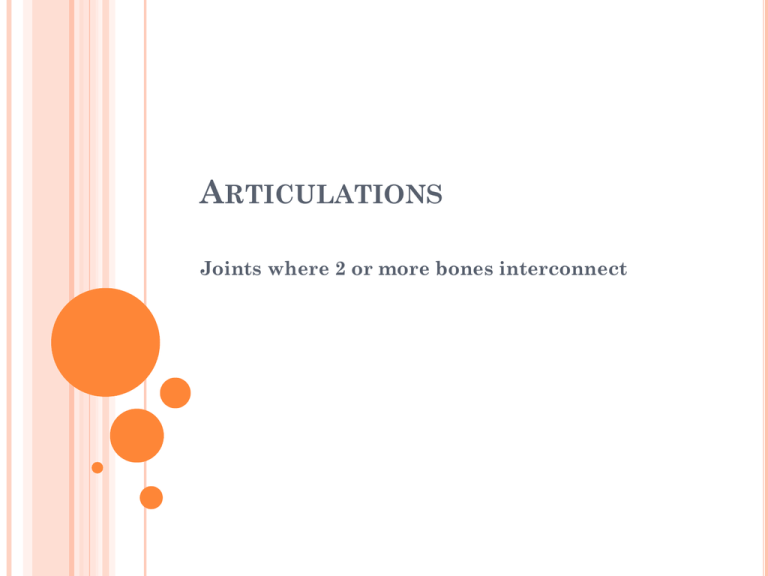
ARTICULATIONS Joints where 2 or more bones interconnect MOVEMENT The body is adapted to movement, which occurs only at joints where 2 bones connect (articulations). Joints have different structures that determine the direction and distance they can move. Joints always compromise strength and stability to increase mobility. CLASSIFICATION OF JOINTS Synarthrosis: immovable joints, are bound together by fibrous or cartilaginous connections, which may fuse over time. 1. syndesmosis: bones connected by ligaments 2. symphysis: bones separated by fibrocartilage Amphiarthrosiss: lightly moveable joints, may have fibrous or cartilaginous connections. Diarthrosis: freely moveable, and are subdivided by type of motion. DIARTHROSES Diarthroses (synovial joints) are found at the ends of long bones, within articular capsules lined with synovial membrane. The articulating surfaces of the bones within the articular capsules are padded with hyaline (articular cartilage), which prevent the bones from touching. The smooth surfaces are lubricated by synovial fluid to reduce friction. SYNOVIAL JOINT Articular Capsule Articular Cartilage Synovial Fluid lubrication nutrient distribution shock absorption *like all amphiarthrois and synarthrosis, they have ligaments connecting bones. TYPES OF DIARTHROSIS (SYNOVIAL JOINTS) ACCESSORY STRUCTURES 1. Cartilages and fat pads cushion the joint. a fibrocartilage (meniscus/labrum) lies between bones fat pads superficial to the joint capsule protect articular cartilages 2. Various kinds of accessory ligaments support and strengthen joints. 3. Tendons attached to muscles around a joint help support the joint. 4. Bursae are pockets of synovial fluid that cushion areas where tendons or ligaments rub. JOINT STABILITY Several factors stabilize joints and prevent injury by limiting range of motion: 1. collagen fibers of the joint capsule and associated ligaments 2. the shapes of articulating surfaces and fibrous cartilage 3. other bones, muscles, or fat pads around the joint 4. tendons of opposing (articulating) bones may help control or limit movement SPRAIN Injury to a ligament Ranges from a micro tear to a rupture DISLOCATION, LUXATION, SUBLUXATION An injury to a joint in which articulating surfaces are forced out of position is called a dislocation (luxation). A partial dislocation is a subluxation. Luxation can damage articular cartilage, tear ligaments, or distort the joint capsule. SYNOVIAL JOINT DYNAMIC MOTION 1. In linear motion, the pencil maintains its vertical orientation, but changes its position. 2. In angular motion, the pencil maintains its position, but changes it orientation. (A circular angular motion is called circumduction.) 3. When the pencil maintains both its position and orientation, but spins on its axis, this motion is called rotation. FLEXION AND EXTENSION Flexion: in the anterior-posterior plane reduces the angle between elements Extension: in the anterior-posterior plane increases the angle between elements Hyperextension: extension past anatomical position ABDUCTION AND ADDUCTION Abduction: moves away from the midline of the body Adduction: moves toward the midline of the body ROTATION rotation: the direction of a rotation from anatomical position, relative to the longitudinal axis of the body. left or right rotation medial rotation (inward rotation): rotates toward the axis lateral rotation (outward rotation): rotates away from the axis PRONATION AND SUPINATION - pronation: rotates the forearm, radius over ulna (palm down) - supination: the forearm in anatomical position (palm up) DORSIFLEXION AND PLANTARFLEXION dorsiflexion: flexion at the ankle (lifting toes) plantar flexion: extension at the ankle (pointing toes) inversion: twists the sole of the foot medially eversion: twists the sole of the foot laterally INTERVERTEBRAL ARTICULATIONS SHOULDER JOINT ELBOW HIP KNEE Patellofemoral joint ANKLE ARTHRITIS GOUT INTEGRATION WITH OTHER SYSTEMS Structure, support, protection Base for motion
